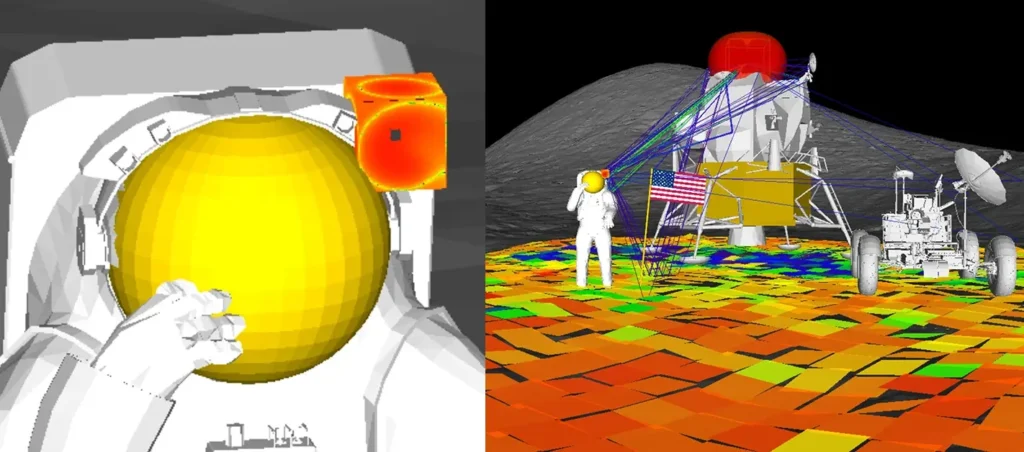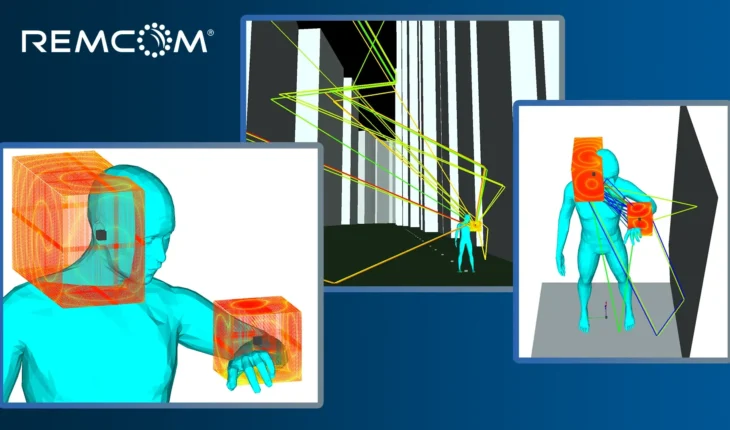XFdtd and Wireless InSite integration enables realistic antenna performance analysis.

Remcom announces the integration of XFdtd 3D Electromagnetic Simulation Software with Wireless InSite 3D Wireless Propagation Software through a new Huygens surface capability. The update also includes dynamic mobility, enabling the movement of RF systems, vehicles, and people through virtual wireless scenarios. These developments enable seamless interoperability between high-resolution near-field simulations and efficient 3D ray-tracing, supporting applications such as GNSS, 6G connectivity, lunar missions, and on-body communication while in motion.
With XFdtd’s full-wave simulation capabilities, RF engineers can capture steady-state electric and magnetic field data for complex designs involving MCAD, ECAD, PCB, scatterers, and circuit matching networks. Remcom’s unique Huygens surface capability maintains fidelity while incorporating these results into large-scale scenarios within indoor spaces, urban areas, or complex outdoor environments. Through this interface, near-field complex electromagnetic field data are transferred from XFdtd to Wireless InSite via a simplified workflow, using precise ray-tracing to calculate propagation and multipath in large indoor and outdoor scenes with mobile devices, people, and vehicles.

Wireless InSite calculates communication metrics such as propagation paths, S-parameters, received power, SINR, and data throughput while maintaining the correct relative positions of geometry and antenna field data in dynamic scenarios. The Huygens configuration can be placed anywhere in the scene and moved through time via mobility options that reveal how motion or moving objects and people affect fading and shadowing.
Key applications supported by the new integration include:
- GNSS Positioning: The solution enables accurate modeling of handheld devices on walking humans in urban environments, capturing multipath effects from 3D structures and signal losses from foliage, as observed from moving satellites.
- NASA Artemis Program: Remcom supports future lunar missions with wireless channel simulation and coverage analysis for lunar environments, including simulation of MIMO antennas on spacesuits during moonwalks, digital elevation maps (DEM), and analysis of network performance impacts due to regolith dust, sub-surface scattering, and blockage from rovers and craters.
- 5G/6G Connectivity for UAVs, Automotive, and Robotics: In AI-native 6G networks, performance will be driven by ML algorithms that require training data. These can be enabled through Wireless InSite’s mobility and EES metamaterials features combined with accurate simulation of propagation and multipath in complex indoor, outdoor, terrestrial, satellite, and non-terrestrial environments.
- On-Body Communications: XFdtd and Wireless InSite provide unique on-body communication modeling for wearables, including smartphones, earbuds (TWS), smartwatches, UWB positioning tags, 5G UE sidelink, and smart rings. This allows RF engineers to analyze interactions between the human and the device and optimize wireless performance across wearable ecosystems.
“Remcom’s Huygens technology merges the worlds of full-wave and ray-tracing to bring accurate near-field results to challenging electrically large environments,” said Tarun Chawla, director of business development at Remcom. “As wireless devices proliferate on complex scatterers like the human body or vehicles, accurately modeling effects like blockage, dielectric refraction, and antenna detuning is crucial. These requirements are driven by RF testing, including anechoic chamber and OTA channel sounding, which need correlation with RF digital twins. Remcom datasets are being used to digitize RF test and measurement using AI/ML models, capturing real-world wireless system user experience, from subcircuit to channel. We’re helping NASA achieve this for challenging Artemis missions by simplifying complex antenna analysis in dynamic scenarios. This integration between XFdtd and Wireless InSite is the first step toward a unified Remcom EM platform.”
For more information, visit remcom.com.





